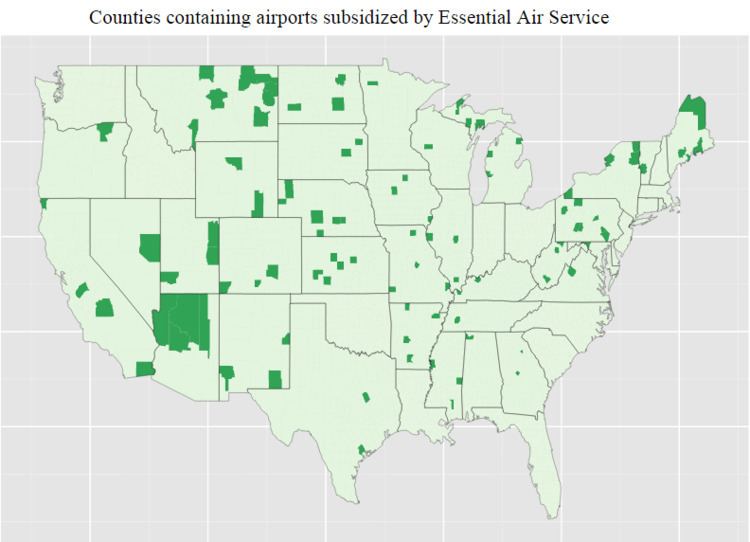 | ||
Essential Air Service (EAS) is a U.S. government program enacted to guarantee that small communities in the United States, which, prior to deregulation, were served by certificated airlines, maintained commercial service. Its aim is to maintain a minimal level of scheduled air service to these communities that otherwise would not be profitable. This came in response to the Airline Deregulation Act, passed in 1978, which gave U.S. airlines almost total freedom to determine which markets to serve domestically and what fares to charge for that service. The program is codified at 49 U.S.C. §§ 41731–41748.
Contents
- Criteria
- Controversy
- Essential Air Service Report Tables
- Alternate Essential Air Service
- Community Flexibility Pilot Program
- Communities Formerly Having Subsidized EAS
- References
The United States Department of Transportation (USDOT) subsidizes airlines to serve communities across the country that otherwise would not receive any scheduled air service. As of November 1, 2013, the Essential Air Service subsidized 160 communities, of which 43 were in Alaska, whose guidelines for service are separate and distinct from the rest of the country. The decision as to what degree of subsidized service a community requires is made based on identifying a specific hub for the community and from there determining the number of trips, seats, and type of aircraft that are necessary to serve that hub.
Congressional panels expected the funding for the program to increase slightly to $114 million in 2007. However, the George W. Bush Administration sought to reduce the cost of the program to $50 million by stricter eligibility criteria and requiring the local governments of the areas served to contribute to the cost. The budget for EASs increased from $131.5 million in 2011 to $214 million in 2012 to $234 million in 2013 and to $241 million in 2014. The Heritage Foundation argued in 2014 that rural airports should receive no federal subsidies through the Essential Air Service program; rather, state and local governments that value the air services should support them. The Congressional Research Service has reported that since the early 2000s federal subsidies for the EAS have nearly tripled to almost $300 million per year.
Criteria
Pursuant to the Department of Transportation and Related Agencies Appropriations Act, 2000, no community within the lower 48 states may receive a subsidy greater than $200 per passenger unless the community is more than 210 miles from the nearest large or medium hub airport. To be eligible for the program, a community in the lower 48 states must either maintain an average of 10 or more enplanements per service day or be located more than 175 miles from the nearest large or medium hub airport.
Controversy
Critics question the economic efficiency of the service. According to a 2006 New York Times article on the program, the subsidy per passenger, averaged across the entire program excluding Alaska, is approximately $74, and much higher on some particularly poorly-patronized flights where subsidies are as high as $801 per passenger.
Patronage on many flights is very low. The majority of EAS airplanes have fewer than 20 seats, and flights typically are less than half full. However, the program is politically popular in the cities receiving the subsidized flights, many of which use an airport with scheduled service as a selling point to attract industry to their regions.
Several subsidized airports are within an hour's drive from an unsubsidized airport. For example:
Some subsidized airports are within driving distance of multiple unsubsidized airports. For example:
Essential Air Service Report Tables
The following tables list all Essential Air Service communities under the various funding programs. This is based on the most recent reports issued by the U.S. Department of Transportation (DOT), and updated to reflect changes based on DOT orders published at [Regulations.gov]. Docket and order numbers link to their respective pages on the docket management site, which typically includes the original files in PDF and other formats.
Alternate Essential Air Service
The Alternate Essential Air Service program grants funds directly to the municipality or airport authority instead of the air carrier. This allows the community to recruit air service that would not otherwise meet EAS guidelines, such as more frequent service with smaller aircraft, less-than-daily service, flights to differing destinations at different times of the year or week, on-demand air taxi service, scheduled or on-demand ground surface transportation, regionalized air service, or even purchasing an aircraft. This alternative program has most often occurred as a public charter arrangement as prescribed by Title 14 of the Code of Federal Regulations, Part 380. The first airport to enter this program was Manistee County Blacker Airport in 2012.
Community Flexibility Pilot Program
Up to ten communities may forego their EAS for a period of ten years in exchange for a grant equal to two years’ subsidy.
Communities Formerly Having Subsidized EAS
The following tables list airports which formerly had Essential Air Service subsidized routes.
